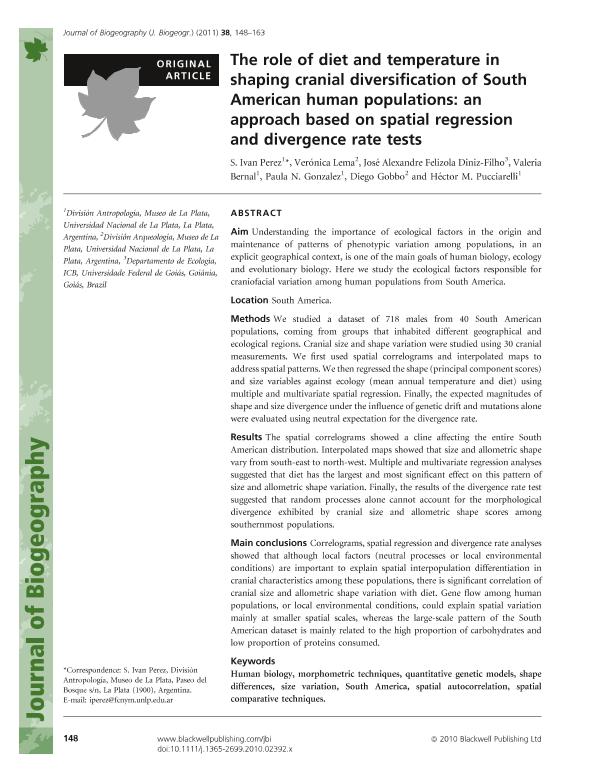Mostrar el registro sencillo del ítem
dc.contributor.author
Perez, Sergio Ivan

dc.contributor.author
Lema, Verónica
dc.contributor.author
Diniz-Filho, José Alexandre Felizola
dc.contributor.author
Bernal, Valeria

dc.contributor.author
Gonzalez, Paula Natalia

dc.contributor.author
Gobbo, Juan Diego

dc.contributor.author
Pucciarelli, Hector Mario

dc.date.available
2023-05-19T18:46:40Z
dc.date.issued
2010-09
dc.identifier.citation
Perez, Sergio Ivan; Lema, Verónica; Diniz-Filho, José Alexandre Felizola; Bernal, Valeria; Gonzalez, Paula Natalia; et al.; The role of diet and temperature in shaping cranial diversification of South American human populations: An approach based on spatial regression and divergence rate tests; Wiley Blackwell Publishing, Inc; Journal of Biogeography; 38; 1; 9-2010; 148-163
dc.identifier.issn
0305-0270
dc.identifier.uri
http://hdl.handle.net/11336/198223
dc.description.abstract
Aim- Understanding the importance of ecological factors in the origin and maintenance of patterns of phenotypic variation among populations, in an explicit geographical context, is one of the main goals of human biology, ecology and evolutionary biology. Here we study the ecological factors responsible for craniofacial variation among human populations from South America.Location- South America.Methods- We studied a dataset of 718 males from 40 South American populations, coming from groups that inhabited different geographical and ecological regions. Cranial size and shape variation were studied using 30 cranial measurements. We first used spatial correlograms and interpolated maps to address spatial patterns. We then regressed the shape (principal component scores) and size variables against ecology (mean annual temperature and diet) using multiple and multivariate spatial regression. Finally, the expected magnitudes of shape and size divergence under the influence of genetic drift and mutations alone were evaluated using neutral expectation for the divergence rate.Results- The spatial correlograms showed a cline affecting the entire South American distribution. Interpolated maps showed that size and allometric shape vary from south-east to north-west. Multiple and multivariate regression analyses suggested that diet has the largest and most significant effect on this pattern of size and allometric shape variation. Finally, the results of the divergence rate test suggested that random processes alone cannot account for the morphological divergence exhibited by cranial size and allometric shape scores among southernmost populations.Main conclusions- Correlograms, spatial regression and divergence rate analyses showed that although local factors (neutral processes or local environmental conditions) are important to explain spatial interpopulation differentiation in cranial characteristics among these populations, there is significant correlation of cranial size and allometric shape variation with diet. Gene flow among human populations, or local environmental conditions, could explain spatial variation mainly at smaller spatial scales, whereas the large-scale pattern of the South American dataset is mainly related to the high proportion of carbohydrates and low proportion of proteins consumed.
dc.format
application/pdf
dc.language.iso
eng
dc.publisher
Wiley Blackwell Publishing, Inc

dc.rights
info:eu-repo/semantics/openAccess
dc.rights.uri
https://creativecommons.org/licenses/by-nc-sa/2.5/ar/
dc.subject
HUMAN BIOLOGY
dc.subject
MORPHOMETRIC TECHNIQUES
dc.subject
QUANTITATIVE GENETIC MODELS
dc.subject
SHAPE DIFFERENCES
dc.subject
SIZE VARIATION
dc.subject
SOUTH AMERICA
dc.subject
SPATIAL AUTOCORRELATION
dc.subject
SPATIAL COMPARATIVE TECHNIQUES
dc.subject.classification
Biología

dc.subject.classification
Ciencias Biológicas

dc.subject.classification
CIENCIAS NATURALES Y EXACTAS

dc.title
The role of diet and temperature in shaping cranial diversification of South American human populations: An approach based on spatial regression and divergence rate tests
dc.type
info:eu-repo/semantics/article
dc.type
info:ar-repo/semantics/artículo
dc.type
info:eu-repo/semantics/publishedVersion
dc.date.updated
2023-04-10T10:15:00Z
dc.journal.volume
38
dc.journal.number
1
dc.journal.pagination
148-163
dc.journal.pais
Reino Unido

dc.journal.ciudad
Londres
dc.description.fil
Fil: Perez, Sergio Ivan. Consejo Nacional de Investigaciones Científicas y Técnicas. Centro Científico Tecnológico Conicet - La Plata; Argentina. Universidad Nacional de La Plata. Facultad de Ciencias Naturales y Museo. Departamento Científico de Antropología; Argentina
dc.description.fil
Fil: Lema, Verónica. Universidad Nacional de La Plata. Facultad de Ciencias Naturales y Museo. División Arqueología; Argentina
dc.description.fil
Fil: Diniz-Filho, José Alexandre Felizola. Universidade Federal de Goiás; Brasil
dc.description.fil
Fil: Bernal, Valeria. Consejo Nacional de Investigaciones Científicas y Técnicas. Centro Científico Tecnológico Conicet - La Plata; Argentina. Universidad Nacional de La Plata. Facultad de Ciencias Naturales y Museo. Departamento Científico de Antropología; Argentina
dc.description.fil
Fil: Gonzalez, Paula Natalia. Consejo Nacional de Investigaciones Científicas y Técnicas. Centro Científico Tecnológico Conicet - La Plata; Argentina. Universidad Nacional de La Plata. Facultad de Ciencias Naturales y Museo. Departamento Científico de Antropología; Argentina
dc.description.fil
Fil: Gobbo, Juan Diego. Consejo Nacional de Investigaciones Científicas y Técnicas. Centro Científico Tecnológico Conicet - La Plata; Argentina. Universidad Nacional de La Plata. Facultad de Ciencias Naturales y Museo. División Arqueología; Argentina
dc.description.fil
Fil: Pucciarelli, Hector Mario. Consejo Nacional de Investigaciones Científicas y Técnicas. Centro Científico Tecnológico Conicet - La Plata; Argentina. Universidad Nacional de La Plata. Facultad de Ciencias Naturales y Museo. Departamento Científico de Antropología; Argentina
dc.journal.title
Journal of Biogeography

dc.relation.alternativeid
info:eu-repo/semantics/altIdentifier/url/https://onlinelibrary.wiley.com/doi/10.1111/j.1365-2699.2010.02392.x
dc.relation.alternativeid
info:eu-repo/semantics/altIdentifier/doi/http://dx.doi.org/10.1111/j.1365-2699.2010.02392.x
Archivos asociados
